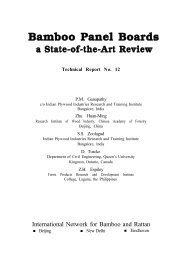The Bamboo and Rattan Sectors in Asia: an Analysis of ... - INBAR
The Bamboo and Rattan Sectors in Asia: an Analysis of ... - INBAR
The Bamboo and Rattan Sectors in Asia: an Analysis of ... - INBAR
Create successful ePaper yourself
Turn your PDF publications into a flip-book with our unique Google optimized e-Paper software.
egular clients <strong><strong>an</strong>d</strong> relatives. Brahm<strong>in</strong>s <strong><strong>an</strong>d</strong> Kshetriyas do not know <strong>an</strong>y bamboo<br />
work <strong><strong>an</strong>d</strong> depend on Dom/Chamar/Sarkis/Dushad castes for their needs. Most craft<br />
workers are <strong>in</strong> the age group <strong>of</strong> 40-70 years, <strong><strong>an</strong>d</strong> the best ones tend to be the oldest,<br />
between 60 <strong><strong>an</strong>d</strong> 70. Nearly all craft workers are men, although women among the hill<br />
tribes are <strong>in</strong>creas<strong>in</strong>gly tak<strong>in</strong>g up craftwork. <strong>The</strong> younger people are choos<strong>in</strong>g not to<br />
enter the trade, <strong><strong>an</strong>d</strong> are seek<strong>in</strong>g out better pay<strong>in</strong>g <strong><strong>an</strong>d</strong> less arduous vocations. Some<br />
youths who have started bamboo furniture units have done so <strong>in</strong> association with<br />
ratt<strong>an</strong> furniture m<strong>an</strong>ufactur<strong>in</strong>g.<br />
<strong>Bamboo</strong> craft is not a full-time occupation: it is seasonal <strong><strong>an</strong>d</strong> sporadic, practiced<br />
whenever the need arises. This allows the crafts people to participate <strong>in</strong> a diverse<br />
r<strong>an</strong>ge <strong>of</strong> activities, <strong>in</strong>clud<strong>in</strong>g hunt<strong>in</strong>g <strong><strong>an</strong>d</strong> fish<strong>in</strong>g, collect<strong>in</strong>g forest produce, <strong><strong>an</strong>d</strong><br />
work<strong>in</strong>g as wage labor <strong>in</strong> agriculture, road construction <strong><strong>an</strong>d</strong> brick kilns. Most craft<br />
families are l<strong><strong>an</strong>d</strong>less though some have small l<strong><strong>an</strong>d</strong> hold<strong>in</strong>gs. This occupational<br />
diversity provides some security <strong>in</strong> the event <strong>of</strong> a crop failure from <strong>in</strong>clement climate<br />
or pests.<br />
<strong>Bamboo</strong> craft workers have a number <strong>of</strong> possible outlets for their products. As<br />
mentioned earlier, some work is done on a custom basis, where artifacts are<br />
m<strong>an</strong>ufactured to order. Whenever the need arises, consumers place orders with artis<strong>an</strong>s<br />
<strong>in</strong> their village or <strong>in</strong> nearby villages. Every year, around October-November,<br />
occupational castes visit their client villages to make various bamboo products (baskets,<br />
w<strong>in</strong>now<strong>in</strong>g trays, tools <strong><strong>an</strong>d</strong> traps, etc.). <strong>The</strong>y are paid daily wages <strong>of</strong> Rs 50, plus<br />
meals (US$1 = Rs 56.78) 4 . <strong>The</strong>y also make storage b<strong>in</strong>s (bhakaris) for which they<br />
charge by the size (Rs 2/kg). Raw materials are provided by the client. <strong>The</strong>se craft<br />
workers usually stay for 10-15 days <strong>in</strong> a village before mov<strong>in</strong>g on to the next village.<br />
<strong>The</strong>y have proprietary territories <strong><strong>an</strong>d</strong> are very protective <strong>of</strong> them. <strong>The</strong>re is also <strong>an</strong><br />
<strong>in</strong>formal exch<strong>an</strong>ge system or barter trade prevalent to a considerable scale at the<br />
village level.<br />
<strong>Bamboo</strong> items (baskets, w<strong>in</strong>now<strong>in</strong>g trays, etc.) are also sold <strong>in</strong> more formal<br />
market sett<strong>in</strong>gs, such as local bazaars, along with other goods. Customers come from<br />
nearby villages to these markets. When the market is near a highway, travellers <strong><strong>an</strong>d</strong><br />
truckers from larger cities <strong><strong>an</strong>d</strong> from India purchase goods for themselves or for resale.<br />
Typically at these markets, the craft people sell their wares, <strong><strong>an</strong>d</strong> those <strong>of</strong> their<br />
associates, directly to the customer. Each craft worker may br<strong>in</strong>g up to 10 large<br />
baskets, 5-10 cyl<strong>in</strong>drical baskets, 20-50 w<strong>in</strong>now<strong>in</strong>g trays, etc. to the market per visit.<br />
<strong>The</strong> scale <strong>of</strong> tr<strong>an</strong>sactions is small. If a craft worker m<strong>an</strong>ages to sell all the wares<br />
brought, he/she may return home with Rs 300-500, to share among associates.<br />
<strong>The</strong>re are also regional markets at Lah<strong>an</strong>, Biratnagar <strong><strong>an</strong>d</strong> J<strong>an</strong>akpur where artis<strong>an</strong>s<br />
sell their products to agents or traders who, <strong>in</strong> turn, sell to large farmers <strong><strong>an</strong>d</strong> to<br />
wholesale merch<strong>an</strong>ts. <strong>The</strong> agents travel from as far away as 400 km from Kathm<strong><strong>an</strong>d</strong>u<br />
4 All exch<strong>an</strong>ge rates quoted are, unless otherwise mentioned, as per Interb<strong>an</strong>k exch<strong>an</strong>ge rate <strong>of</strong> 01.01.1997.<br />
14












